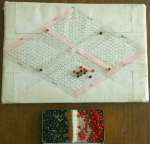
Standard 11x11 board (when Black resigns)

Same game with 'predictable' moves added

Portable board - 22x22 with masks for 11x11
| Home page | Bellringing | Talks & lectures | Fell walking | Settle - Carlisle | Metal sculpture | Brickwork | Journeys | Ergonomics | The rest | Site map |
| The perfect game | Boards | Play | Pictures | Links |
|---|
I discovered the game of Hex as a student, and was fascinated by it. It was invented by the Danish mathematician Piet Hein during the war but I discovered it in the 60s. It's played on a rhombic array of hexagonal cells, normally 11x11 though any size if possible. Each player takes it in turn to place a piece on one of the cells, and they continue doing this until one or other has a line of occupied cells joining the two sides 'owned' by the player. It doesn't matter how sinuous the line it so long it it is continuous. Obviously each player tries to establish his/her own line and/or to frustrate the other player doing so . In fact the two are equivalent because the only way to stop all lines between one pair of sides is to establish one between the other two.
On every count it seemed to be the 'ideal game'.
You can play with pencil and paper but it's more satisfying to use a board. They have been sold in the past but are no more, so I decided to make my own. The base is hardboard with the pattern drawn on thin card, glued to the base and then varnished for protection. A rhombic board would be a bit awkward so I made it rectangular, and rather than leave the corners empty I used the griffin that was the emblem of my old school, Brunts in Mansfield. (Most of the buildings are long gone and the site is now a business park, but the school lives on in new buildings on what was the playing field. So does the griffin on the badge.) The edges of the board are coloured according to which player 'owns' them. Strictly they should be black and white, but since white was the background I used a different colour, red, for the 'white' edges.
At the time I made it my friends were interested in three-way chess. By happy coincidence an eight sided hexagon fits neatly in the standard 11x11 rhombic Hex board, so I made it dual purpose – the central area has three cell colours but these are ignored in Hex. I also bought an extra set of chess men and stained all the white pieces brown for the third colour.
The board is quite big so I also made a portable version – a piece of fibre board (as used for pinning notices) covered in paper with the board pattern printed on it. The pieces were the tiny coloured push pins. After making a standard 11x11 board (which seems to have vanished) I also made a 22x22 board, so we could play a mich bigger game. But I included coloured edge strips that could be pinned to it to reduce the playing area (as shown in the image below).
Playing first gives an obvious advantage, because having an extra piece on the board can never be a disadvantage, so it is sensible for the weaker player to go first. Equally matched players should take it in turn. Despite the proof that the first player can always win by playing optimally, in practice it is by no means guaranteed. In the absence of a known optimal strategy most players use various tactics to try to gain an advantage in a part of the board.
If your opponent seems to be dominating a patch of cells then it may be best to strike somewhere else. It's easy to get too focused on completing a particular line and waste moves on a 'lost cause', when you would be better to use your move where you can create an advantage. All that matters is that you establish a line somewhere, however devious it might be, to connect your edges. It's also helpful to remember that blocking a line for your opponent is just as good a tactic as trying to build your own line.
In some situations you can control a line without actually filling every cell, which allows you to make faster progress. For example, in the first picture below, the line of five white counters running diagonally up from the bottom and through the centre represent a secure line despite not being connected. Between each pair there are two empty cells and if black took any of them white would immediately take the adjacent one and secure the link.
In fact at the position shown black would resign because white has established a guaranteed line. The game could go on for another 12 moves with black putting a counter in one of the cells in each gap and white putting one in the adjacent cell. That's what happens when you play a machine, but human players are more sensible.
Maybe some day I will add some heuristics that I have discovered, but enough for now.
Click to enlarge and use arrows to move between them.
 Standard 11x11 board (when Black resigns) |
 Same game with 'predictable' moves added |
 Portable board - 22x22 with masks for 11x11 |
| Back to top | Return to Home page |